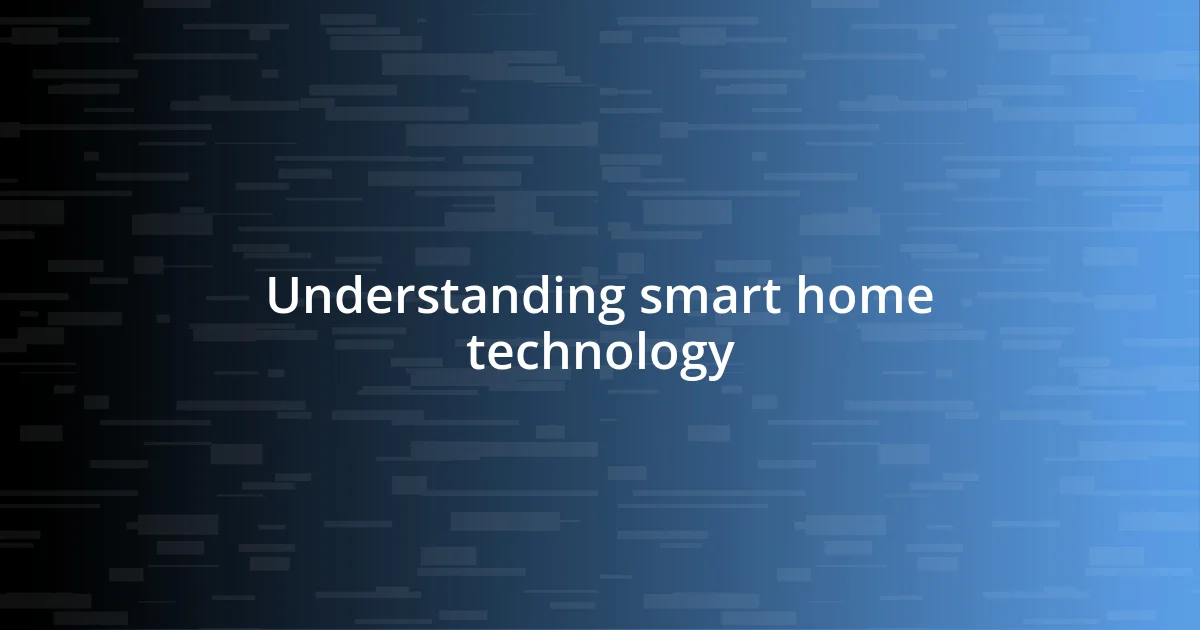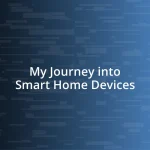Key takeaways:
- Start by assessing your home’s needs to determine comfort, energy use, security, usability, and lifestyle patterns for effective smart home integration.
- Choose devices that align with your lifestyle and ensure compatibility to create a seamless smart home experience.
- Create a smart home plan that outlines your vision and adaptability for future changes, enhancing daily routines without disruption.

Understanding smart home technology
Smart home technology can seem overwhelming at first, but I remember the moment it clicked for me. I was fiddling with my new smart thermostat, adjusting it from my phone while lounging on the couch. How incredible is it to control my home environment without getting off the sofa? It made me realize that this technology is not just about convenience; it’s about creating a lifestyle that adapts to our needs.
When I first dove into smart home devices, I worried about complexity, yet I soon found that many systems integrate seamlessly. One evening, I set up a voice assistant to control my lights, and in an instant, my living room transformed with a simple command. It sparked joy—a little magic moment in my everyday routine. Isn’t it fascinating how a few gadgets can enhance our lives in moments that matter?
Understanding smart home technology also means recognizing its role in energy efficiency. After installing smart plugs, I became more conscious of my energy consumption, turning off devices remotely when I left the house. I felt empowered, knowing that small changes can lead to big savings—not just on my bills, but for the environment too. Isn’t that something we can all rally behind?

Assessing your home’s needs
When it came time to assess my home’s needs, I realized that a thoughtful approach was key. I started by walking through each room, noting how I used the space and where I could improve efficiency and comfort. It was enlightening to observe the little things I hadn’t paid attention to before, like how the lighting in my kitchen could be enhanced for evening cooking or how I’d forget to turn off devices in my home office.
Here’s what I focused on during my assessment:
- Comfort levels: Are there areas that feel too hot or too cold?
- Energy use: Which devices run all day that might benefit from being smart?
- Security needs: Do I feel safe when I’m home and away?
- Usability: How easily can my family and I operate devices and systems?
- Lifestyle patterns: What routines can be optimized for efficiency?
By really considering these aspects, I found opportunities that would make my space not just smarter, but more aligned with my daily life, fostering ease and peace of mind in my home environment.

Choosing the right smart devices
When I started selecting smart devices, I found it essential to prioritize my needs based on that earlier assessment. I initially gravitated towards trendy gadgets, but I quickly realized that not every device would integrate well with my lifestyle. For instance, I opted for smart light bulbs that could change colors and sync with music—an impulse buy that has surprisingly added so much vibrancy to my gatherings with friends. Why not create those memorable moments at home, right?
Researching compatibility was another crucial milestone in my journey. Before purchasing anything, I made sure my chosen smart hubs could communicate with the devices I wanted. It felt almost like assembling a puzzle, ensuring each piece fit snugly into place. I still remember the day when my smart security camera and Smart Assistant worked together seamlessly; it was such a reassuring feeling knowing I could monitor my home in real-time from anywhere!
Here’s a quick comparison of some popular smart devices I considered, which might help you in your own decision-making process:
| Device | Key Feature |
|---|---|
| Smart Thermostat | Energy-saving auto-scheduling |
| Smart Light Bulbs | Customizable colors and remote control |
| Smart Plugs | Remote on/off control for any device |
| Smart Security Cameras | Real-time monitoring via smartphone |

Creating a smart home plan
Creating a smart home plan is about laying a solid foundation before diving into device selection. I found that starting with a clear vision truly guided my process. For example, I envisioned a home that would not only save energy but also cater to our family’s comfort, like having the perfect temperature as we rouse from sleep each morning.
I recall sketching out a rough layout of my home and identifying zones for smart technology implementation. The living room became a hub for entertainment with smart speakers, while the bedroom was designed for health and relaxation with smart sleep aids. It made me realize: how often do we create these intentional spaces in our homes? By mapping it out, I was able to visualize where each smart device would fit best, enhancing our daily routines instead of disrupting them.
One of the most illuminating moments in my planning was when I considered the future. I asked myself, “What changes might my family go through in the next few years?” With two kids and a dog, I knew adaptability was key. Planning for potential upgrades or expansions saved me from redoing everything too soon, and I felt empowered knowing I was paving the way for a flexible, smart home that could grow alongside my family.

Setting up and integrating devices
Setting up my devices was where the magic really began. I remember the thrill of unboxing my smart thermostat and pluggable sensors, eager to see how they’d transform my living space. Each device came with a manual that felt a bit like a treasure map, guiding me to operate them efficiently and integrate them with my smart hub. The first time I successfully adjusted the temperature from my smartphone while lounging on the sofa was a small victory that made me rethink how I interacted with my home.
Integration wasn’t always smooth sailing, though. I hit a snag when my smart lights didn’t sync with my assistant—frustrating! It’s moments like these that really test your patience. Eventually, I discovered that some devices require specific apps for setup, which streamlined the process significantly. For instance, I learned that by creating routines in my smart hub, I could automate my morning coffee and light up the kitchen just as the sun began to rise—what a game-changer! Have you ever wondered how much easier mornings could be with a little tech boost?
A pivotal moment came when I realized that voice commands were my best friend in this journey. I felt like I was living in the future! I could adjust music, lights, and even start my vacuum just by speaking. Adding these features turned my smart home into a versatile space, allowing me to focus more on family time. It reminds me that, at the end of the day, it’s not just about the devices; it’s about enhancing the moments we cherish.














